Aquatic plants or hydrophytes growing in natural reservoirs are not only their decoration, but also perform the functions of cleaning and creating a biological microclimate. Using them when landscaping a pond or pool on the territory of a country house or garden plot will help decorate the landscape.
Adaptation of plants to the aquatic environment
In any pond, river or other body of water, there are always many different plants that grow and reproduce perfectly in their natural environment. They are characterized by leaves with a large surface, sometimes dissected. The root system is usually weak and is designed to be fixed on the bottom soil, some species do without roots. The stems have cavities and a system of intercellular spaces, which helps to consume oxygen when immersed in water, this also keeps them afloat.
Hydrophytes are divided into several species, each of which has its own habitat and performs a specific function in a given biozone. They are also characterized by such a method of reproduction, in which seeds spread under water: when they fall to the bottom, they begin to germinate.
Species of aquatic plants differ from the zone of their location:
- coastal, which are located along the coast, exposing part of the stems and leaves above the surface: horsetail, arrowhead, cattail, reeds, reeds;
- near-water: irises, pondeteria, susak, marigolds, etc.;
- aquatic, in which all life passes at the depth of the reservoir: water moss, hornwort, hara, nitella;
- floating on the surface or in the water column: pistia, moss-fontinalis, water ranunculus, duckweed, vodokras, marsh flower, water chestnut;
- deep or submerged, which take root in the ground, and above the surface there are flowers: a capsule, a water lily, an orontium, a lotus;
- oxygen generators - plants immersed in water and actively releasing oxygen necessary to ensure the life of all the inhabitants of the reservoir: water star, hornwort, marsh turkey, spiked urt.
Plants of natural water bodies
All natural reservoirs are surrounded by thickets of coastal vegetation, which grows in a strip along the banks of rivers, lakes and ponds. An exception can only be the leeward side, which is devoid of large plantings.
Various types and forms of aquatic plants are grouped or arranged in bands depending on the direction of the current or depth. Along the coast, as a rule, there are dense thickets of reeds or reeds with hard leaves. Fish prefer to live among plants with softer stems and leaves.
The species composition of underwater plants in natural water bodies can change quite significantly over time, since some of them deplete the soil, release harmful substances into the bottom, and then die. They are also influenced by climate or weather changes, anthropogenic impact, environmental pollution.
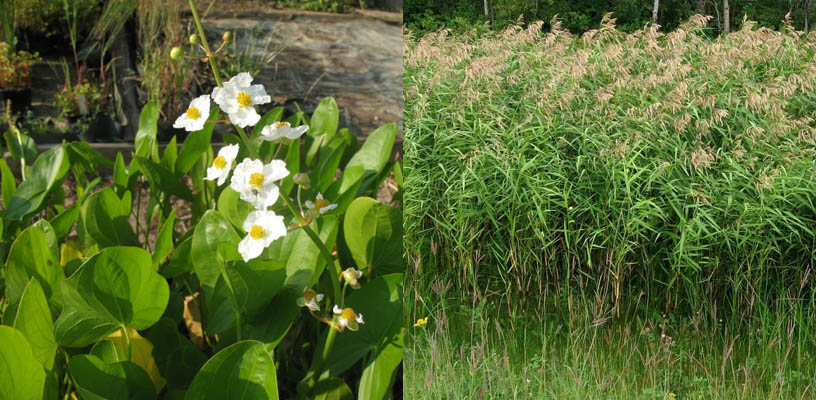
coastal
Plants growing along the perimeter of the reservoir define the border with the shore. These include:
- Aquatic arrowhead plant (sagittaria or common swamp) - widely used for landscaping ponds, its root is represented by cord-like processes with rounded tubers, immersed in water, the stem has a porous tissue filled with air bubbles, its length is 0.2-1.1 m. part has a petiole, the leaves are triangular in shape, similar to an arrowhead up to 30 cm long. In mid-June, the sagittaria blooms and blooms until the end of summer with white flowers with a spherical middle, there may be red or cherry spots inside the petal. In total, there are about 40 species of bog, including ornamental varieties. Many of them are used for decoration and design of man-made reservoirs, and goes well with other aquatic plants.
- Reed or ocheret is a herbaceous plant from the Cereal family, which is found in the middle lane in all water bodies with a depth of up to 1.5 m, has hard stems that scare away fish, has long rhizomes, from which long hollow stems grow up to 5 m tall. The reed inflorescence is a purple-silvery panicle. Used in oriental medicine.
- Skyrpus or reeds - a perennial plant of the reservoir, growing up to 3.5 m tall, has a strong cylindrical stem and a paniculate / capitate inflorescence, prefers swampy places. Many people confuse it with cane.
- Cattail, which is often confused with reeds, has a hard stem with long leaves, at the end of which is a beautiful brown velvet cob with seeds. It grows in water bodies up to 1.5 m deep.
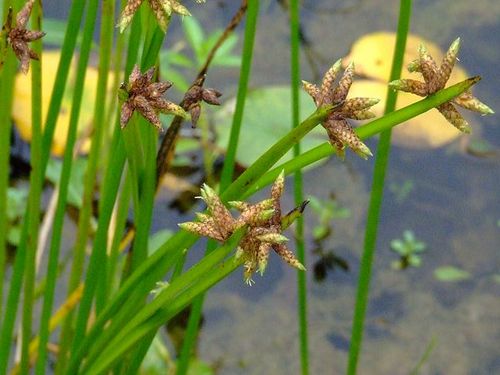
Near water
Submerged or semi-aquatic plants are common in the wild and are available for cultivation in artificial ponds.
Examples of aquatic plants growing in or near shallow water:
- Marsh iris - characterized by bright yellow flowers with a brown pattern, prefers sunlit areas and fertile soil, stem height up to 1.5 m, suitable for reservoirs, planted at a depth of 40 cm.
- Iris smooth - blooms from June to October with blue or purple flowers, up to 1 m high, goes well with other aquatic plants.
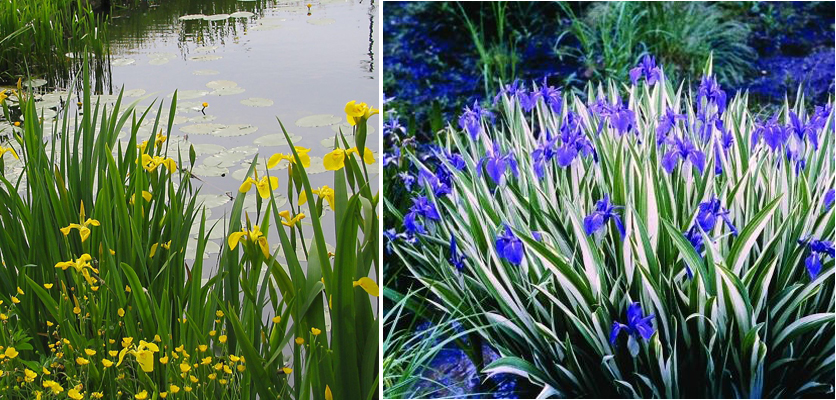
- Marigold (Caltha) (marsh, thin-cup, fistulate, etc.) is a winter-hardy unpretentious plant (poisonous!), Prefers sunny places, tolerates flooding up to 20 cm, has golden, white-yellow flowers, planting depth depends on the variety (20-120 cm).
- Pondeteria - decorated with blue or purple flowers, loves the sun and nutritious soil, a capricious and non-winter-resistant plant (transferred indoors for the winter), planting depth is about 8 cm.
- Susak (Butomus) - an unpretentious plant, blooms with small pink-raspberry flowers, grows very quickly, planting depth is 10 cm.
- Highlander amphibian (Persicaria) - blooms all summer with bright pink small flowers arranged in a cone, when planted they are buried up to 0.5 m, it is better to plant in containers, winter-hardy and unpretentious.
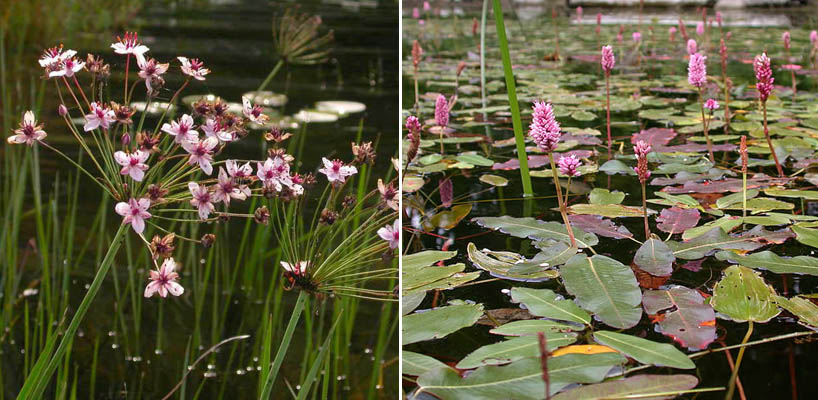
oxygen generators
One of the most important types of underwater plants that supply the entire body of water with additional oxygen. Many of them are also used as fish food. Their advantage is also the improvement of sanitary conditions and the biological treatment of water.
Names of aquatic plants-oxygenerators:
- Common bogweed (Callitriche), which is also called the water star.
- Urut (Myriophyllum) belongs to the perennials of the Slanoberry family, has shoots rising above the water, a creeping rhizome. Long stems (up to 1.5 m) are covered with thin leaves and form an elegant lace of thickets under water, for which it is called the "pinnate". It is grown as a coastal plant, propagated vegetatively, its parts can be planted directly into the ground to a depth of 1.2 m in the spring and summer. It looks great in small ponds, where it forms beautiful patterns under water.


- Hornwort (Ceratophyllum) is dark green, has a long stem, branching at the top. Leaves dissected into segments, grows at a depth of up to 9 m, has a unique aquatic pollination, thanks to which it has spread widely in the water bodies of Russia and other European countries. Instead of roots, it has stems that hold the plant on the ground in the silt. In autumn, the upper part dies off, and shoots with buds hibernate at the bottom of the reservoir.
- Elodea - belongs to the perennials of the Vodokrasov family, lives completely under water, shoots branch up to 1 m long, has small leaves located along the entire stem. It blooms very rarely with small white flowers with red sepals.
floating plants
Such plants can be successfully used to decorate an artificial pond. They do not require care at all, only it is necessary to carefully monitor the growth rate so that the pond is not completely overgrown with them. The difference between these aquatic plants: the roots are not fixed and therefore float freely, and the leaves and flowers are located on the surface.
The most popular floating:
- Duckweed covers the entire surface of the reservoir with a green carpet, represents small plants consisting of stems fastened in several pieces (leaves). It blooms only in artificial reservoirs, propagates vegetatively when young fronds separate from the mother ones, hibernates at the bottom.
- Vodokras (Hydrocharis) is a perennial plant with small rounded leaves, at the base in the form of a heart, from which fleshy roots hang down. The flowers are small, white, located 3-5 cm above the surface of the water above the leaves.
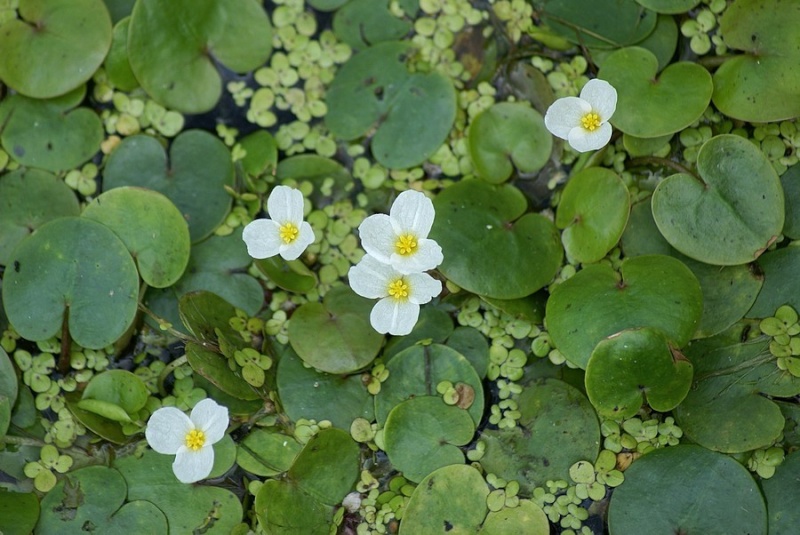
- Azolla (Caroline or fern) came to Europe from the tropical reservoirs of America, resembles openwork moss, grows very quickly, which is why it has to be taken out of the pond with a net, by autumn the leaves become reddish in color.
- Eichhornia (Eichhornia), which has the name "Water Hyacinth", is a floating heat-loving plant with dark green leaves, blooming with lilac-blue or yellow flowers similar to orchids at the end of summer. In autumn, it must be transferred indoors to the aquarium, placing it in an annular float, where the plant successfully winters. According to scientists, it has a fantastic ability to process organic pollutants (that is, it loves dirty water bodies).
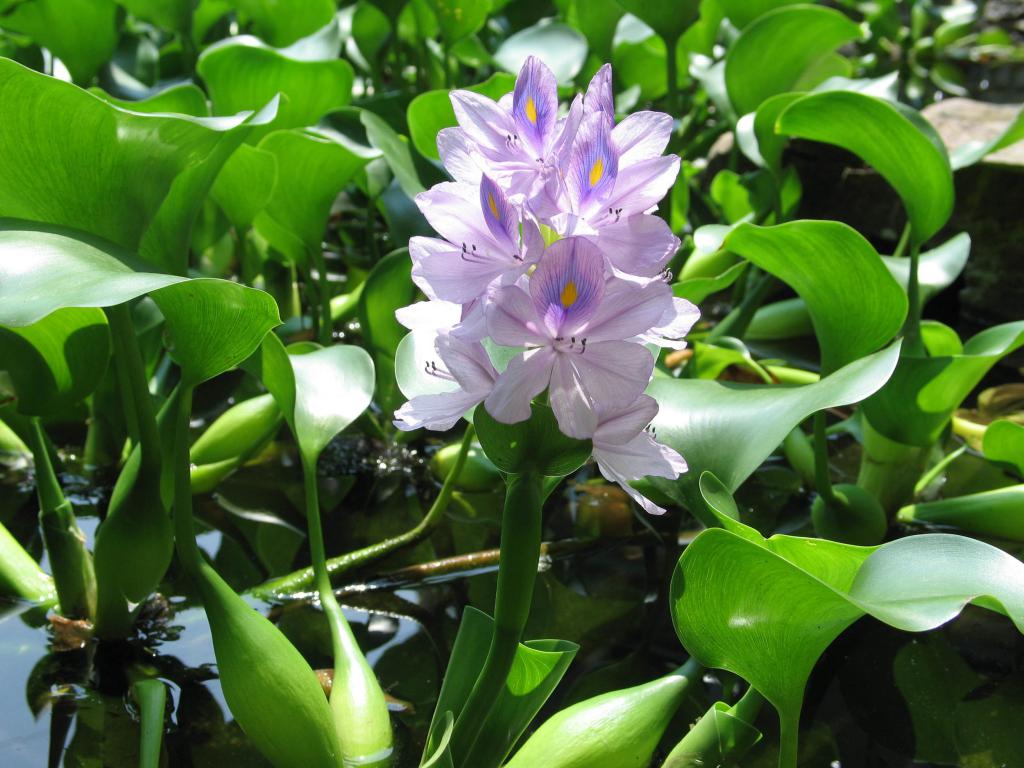
- Water chestnut (Chilim) - an annual, has original fruits, decorated with horns (for which it received the names "damn" and "rogulnik"), with which it clings to the bottom. Floats thanks to the leaves having swellings with an air-bearing layer. It reproduces by self-pollination, but only in regions with a warm climate: in the second half of summer, white flowers appear, protruding above the water, by autumn, hard drupes of 1-15 pieces ripen. on each plant, which gradually sink to the bottom.
deep sea
These aquatic plants have rhizomes buried in the bottom of the reservoir, and stems, leaves and flowers are located above its surface. Their main food is organic matter in the bottom soil. Leaf plates are usually large. This creates a shade and prevents the water from heating up, which helps to prevent the active reproduction of small algae. The main advantage of deep-sea species is beautiful flowering.
Some types of deep sea plants:
- Orontium or "Golden Club" (Orontium) - a perennial with green-blue leaves, silvery below, blooms in April-May with cob inflorescences sticking out of the water (12-15 cm long), consisting of small yellow flowers, similar to white-yellow the pencils.
- Capsule (Nuphar) is a perennial, widely used for landscaping large ponds with shading. Its roots are fixed in the bottom soil, and leaves and yellow flowers float on the surface, located on thick peduncles.
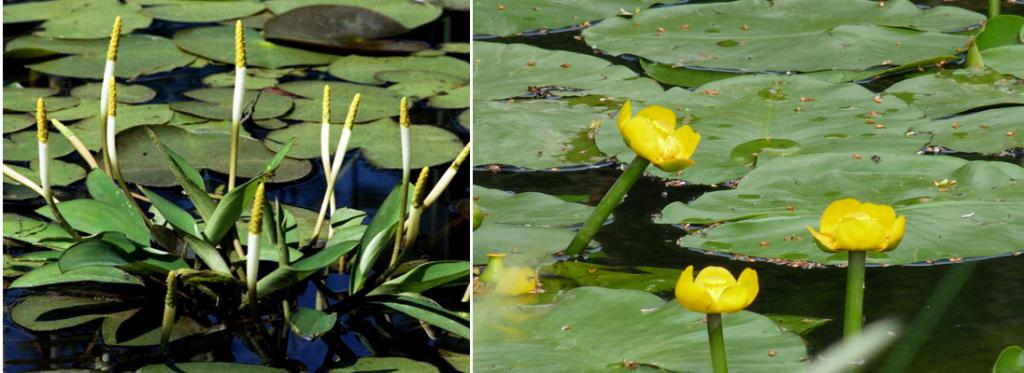
Water lily and lotus
These 2 types of deep-water plants are among the most spectacular and spectacular, having bright beautiful flowers, large leaves. When planting them in a home pond, they will be a wonderful decoration.
The water lily flower (Nymphaea) is named after water nymphs in various European mythologies. It has 35 species and is divided into 2 groups: tropical and winter-hardy. The latter are suitable for cultivation in open water bodies of central and northern Russia, preferring sunny places with stagnant water. The required area for each plant is 0.5-4 square meters. m.
The most common winter-hardy varieties of water lilies:
- The white water lily, which is often found in natural reservoirs, has powerful roots up to 5 cm thick, petioles and peduncles are located on the surface, which begin flowering in May and continue until frost. The leaves are round and wide up to 25 cm, the flowers are snow-white, each lasts 4 days, after which the fruit is tied under water. After ripening, the seeds from the boxes spill out and gradually sink to the bottom, where they then germinate.
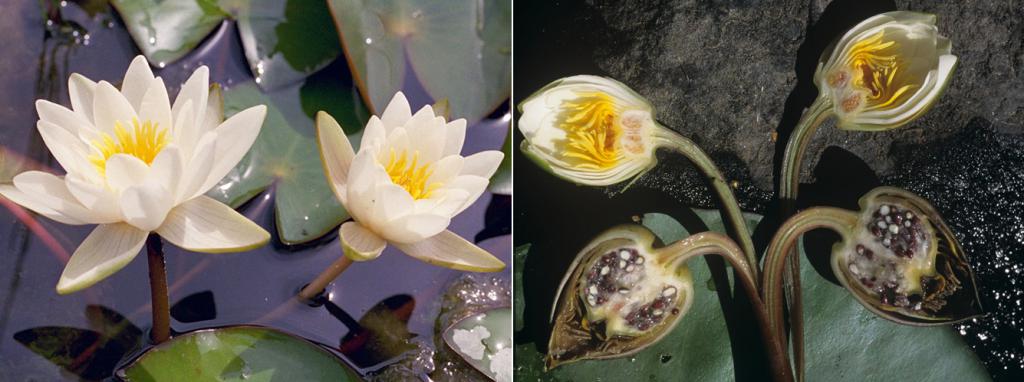
- The fragrant water lily flower is white, emitting a pleasant aroma, the leaves are bright green in color, reddening in the lower part with time. Some cultivars produce yellow (spotted Sulphurea), pink or cream flowers.
- Water lily (nymphea) hybrid - become an adornment of any reservoir, thanks to beautiful flowers and heart-shaped bright leaves (some with spots or red hues).
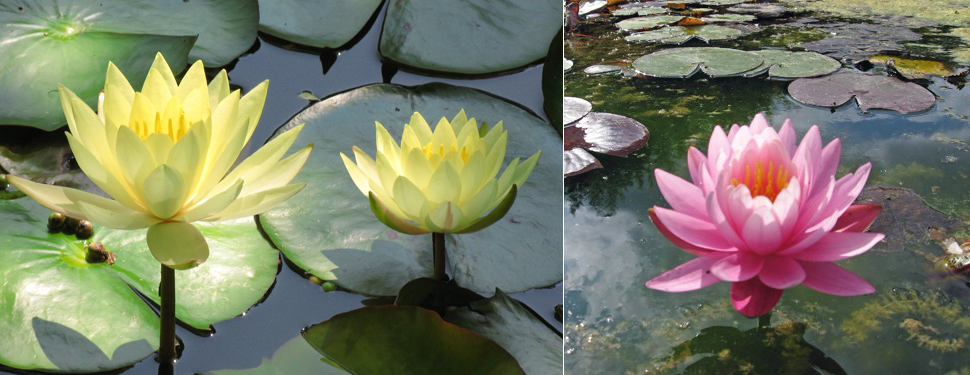
Lotus (Nelumbo) is a perennial aquatic plant, the leaves of which are located both under water and on the surface, funnel-shaped and large, up to 70 cm in diameter. The lotus is decorated with large fragrant flowers (up to 30 cm) with pink-white petals, brightly placed in the center - yellow stamens. The fruits are dark brown in color with 30 seeds, the germination of which lasts for tens and hundreds of years. In the East, this plant is worshiped and told by ancient legends and traditions. In Europe, it has been grown in greenhouses and artificial ponds since the 18th century.

Creating a reservoir: rules
The use of aquatic plants to decorate an artificial reservoir in a garden plot or on the territory of a country house will allow you to create a unique natural landscape and make it possible to admire beautiful leaves and flowers throughout the warm season.
Regardless of the size of such a reservoir, it is necessary to select several types of plants at once with different flowering periods, sizes and shapes of leaves, also taking into account their height and planting depth. The main rule is to maintain biobalance in an artificial pond, in which for the successful coexistence of all plants, fish and microorganisms, it is necessary to make sure that the vegetation covers the water surface by half or more.
The center of the reservoir is given to beautifully flowering plants - water lilies, the variety of which is selected based on the area of \u200b\u200bthe pond. Coastal species (arrowhead, calamus, susak) are planted along the edge, forget-me-nots or marshmallows are planted in shallow water, moisture-loving plants (sedges, irises, daylilies) with a strong root system can be placed on the ground along the edge, which will help save the coast from erosion.
Free-floating species (duckweed, teloris, vodokras) under favorable conditions multiply very quickly and can occupy the entire surface, so they must be periodically removed with a net.
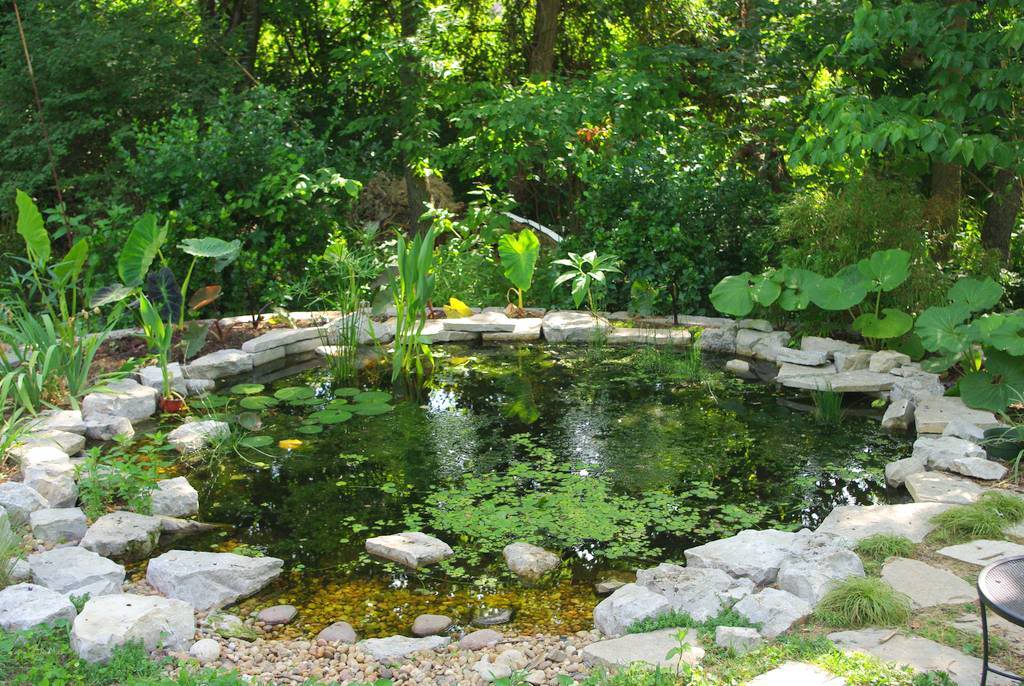
Planting aquatic plants in the pond
Landscaping of an artificial reservoir can be done in 2 ways:
- planting plants in the ground in recesses made along the perimeter of the pond, which is more suitable for steep banks;
- in special containers that are placed on stands or ledges, this method allows you to move them if necessary.
The planting depth depends on the species: for water lilies it is up to 1.5 m, for coastal or marsh ones - 5-20 cm. Optimal planting time: from April to July. Oxygenerators are usually planted first, when water is heated, water lilies are planted, then floating ones, and lastly, they populate the coastal zone.
If desired, fish can be released into the pond, but only after 4-6 weeks, when all the plants take root and the water settles.
Basic rules for planting aquatic plants and arranging a pond:
- place away from deciduous trees so that the falling parts do not clog the reservoir;
- ideal is sunlight in the morning and in the afternoon, and at noon the plants will be comfortable in a small shade;
- fast-growing species should be thinned periodically so that they do not obscure other plants and the surface of the reservoir.
With the right selection of species and varieties of hydrophytes, their growth zones and flowering periods, you can reduce the effort to care for an artificial reservoir. Bright greenery and plants blooming throughout the warm season will decorate the entire surrounding landscape.
